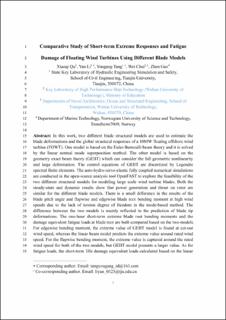| dc.contributor.author | Qu, Xiaoqi | |
| dc.contributor.author | Li, Yan | |
| dc.contributor.author | Tang, Yougang | |
| dc.contributor.author | Chai, Wei | |
| dc.contributor.author | Gao, Zhen | |
| dc.date.accessioned | 2021-05-10T06:28:25Z | |
| dc.date.available | 2021-05-10T06:28:25Z | |
| dc.date.created | 2020-03-01T09:20:16Z | |
| dc.date.issued | 2020 | |
| dc.identifier.citation | Applied Ocean Research. 2020, 97 (102088), . | en_US |
| dc.identifier.issn | 0141-1187 | |
| dc.identifier.uri | https://hdl.handle.net/11250/2754468 | |
| dc.description.abstract | In this work, two different blade structural models are used to estimate the blade deformations and the global structural responses of a 10MW floating offshore wind turbine (FOWT). One model is based on the Euler-Bernoulli beam theory and it is solved by the linear normal mode superposition method. The other model is based on the geometry exact beam theory (GEBT) which can consider the full geometric nonlinearity and large deformation. The control equations of GEBT are discretized by Legendre spectral finite elements. The aero-hydro-servo-elastic fully coupled numerical simulations are conducted in the open-source analysis tool OpenFAST to explore the feasibility of the two different structural models for modeling large scale wind turbine blades. Both the steady-state and dynamic results show that power generation and thrust on rotor are similar for the different blade models. There is a small difference in the results of the blade pitch angle and flapwise and edgewise blade root bending moment at high wind speeds due to the lack of torsion degree of freedom in the mode-based method. The difference between the two models is mainly reflected in the prediction of blade tip deformations. The one-hour short-term extreme blade root bending moments and the damage equivalent fatigue loads at blade root are both compared based on the two models. For edgewise bending moment, the extreme value of GEBT model is found at cut-out wind speed, whereas the linear beam model predicts the extreme value around rated wind speed. For the flapwise bending moment, the extreme value is captured around the rated wind speed for both of the two models, but GEBT model presents a larger value. As for fatigue loads, the short-term 1 Hz damage equivalent loads calculated based on the linear beam model are smaller than GEBT model at almost all load cases for both edgewise and flapwise root bending moment, which implies that the linear beam model may underestimate the life time fatigue damage at blade root. | en_US |
| dc.language.iso | eng | en_US |
| dc.publisher | Elsevier | en_US |
| dc.rights.uri | http://creativecommons.org/licenses/by-nc-nd/4.0/ | |
| dc.title | Comparative study of short-term extreme responses and fatigue damages of a floating wind turbine using two different blade models | en_US |
| dc.type | Journal article | en_US |
| dc.type | Peer reviewed | en_US |
| dc.description.version | acceptedVersion | en_US |
| dc.source.pagenumber | 16 | en_US |
| dc.source.volume | 97 | en_US |
| dc.source.journal | Applied Ocean Research | en_US |
| dc.source.issue | 102088 | en_US |
| dc.identifier.doi | 10.1016/j.apor.2020.102088 | |
| dc.identifier.cristin | 1798688 | |
| dc.description.localcode | Publisher embargo applies until April 1, 2022, © 2021. This manuscript version is made available under the CC-BY-NC-ND 4.0 license http://creativecommons.org/licenses/by-nc-nd/4.0/ | en_US |
| cristin.ispublished | true | |
| cristin.fulltext | postprint | |
| cristin.qualitycode | 1 | |

